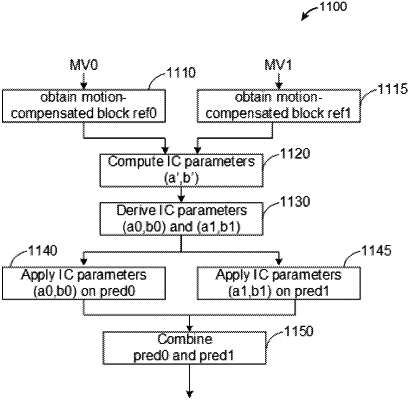| CPC H04N 19/577 (2014.11) [H04N 19/583 (2014.11)] | 26 Claims |

|
1. A method of video decoding comprising:
applying an illumination compensation mode to a current block of a current picture, the illumination compensation mode comprising:
obtaining a first motion compensated reference block of the current block designated by first motion information in a first reference picture and a second motion compensated reference block of the current block designated by second motion information in a second reference picture;
determining an initial set of parameters of an illumination compensation linear model, the initial set of parameters minimizing a sum of a squared difference or a sum of an absolute difference between values of samples of the first motion compensated reference block of the first reference picture of the current block and values of samples of the second motion compensated reference block of the second reference picture of the current block;
deriving a first set of parameters of the illumination compensation linear model allowing compensating variation of illumination between the first motion compensated reference block and the current block and a second set of parameters of the illumination compensation linear model allowing compensating variation of illumination between the second motion compensated reference block and the current block, the first set and the second set being derived from the initial set of parameters and from a value representing a relative temporal distance of the current picture to the reference pictures;
applying the illumination compensation linear model with the derived first set of parameters to the first motion compensated reference block to obtain a first illumination compensated predictor, and applying the illumination compensation linear model with the derived second set of parameters to the second motion compensated reference block to obtain a second illumination compensated predictor; and
reconstructing the current block based on the first and the second illumination compensated predictors.
|